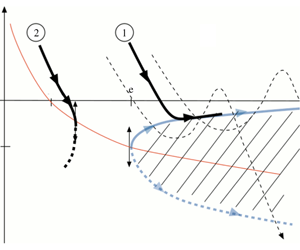Article contents
Analytical study of the direct initiation of gaseous detonations for small heat release
Published online by Cambridge University Press: 17 June 2020
Abstract

An analysis of the direct initiation of gaseous detonations in a spherical geometry is presented. The full set of constitutive equations is analysed by an asymptotic analysis in the double limit of Mach number close to unity (small heat release) and large thermal sensitivity. The quasi-steady curvature-induced quenching phenomenon is first revisited in this limit. Considering a realistic decrease rate of the rarefaction wave, the unsteady problem is reduced to a single nonlinear hyperbolic equation. The time-dependent velocity of the lead shock is an eigenfunction of the problem when two boundary conditions are imposed to the flow at the lead shock and at the burnt gas side. Following (Liñan et al., C. R. Méc., vol. 340, 2012, pp. 829–844), the boundary condition in the quasi-transonic flow of burnt gas is expressed in terms of the curvature. Focusing our attention on successful initiation, the time-dependent velocity of the lead shock of a detonation approaching the Chapman–Jouguet regime is the solution of a nonlinear integral equation investigated for stable and marginally unstable detonations. By comparison with the quasi-steady trajectories in the phase space ‘propagation velocity versus radius’, the solution exhibits the unsteady effect produced upon the detonation decay by the long time delay of the upstream-running mode for transferring the rarefaction-wave-induced deceleration across the inner detonation structure from the burnt gas to the lead shock. In addition, a new and intriguing phenomenon concerning pulsating detonations is described. Even if the results are not quantitatively accurate, they are qualitatively relevant for real detonations.
JFM classification
- Type
- JFM Papers
- Information
- Copyright
- © The Author(s), 2020. Published by Cambridge University Press
References
- 9
- Cited by


